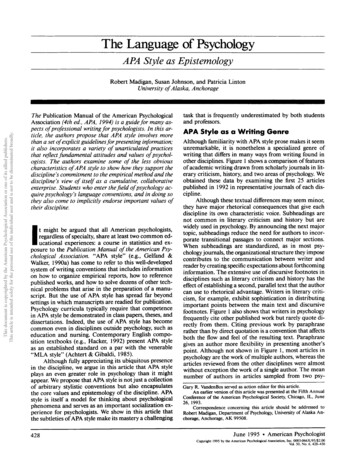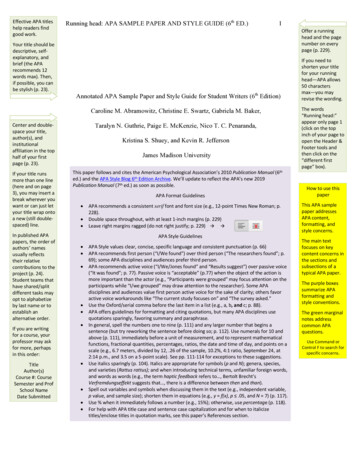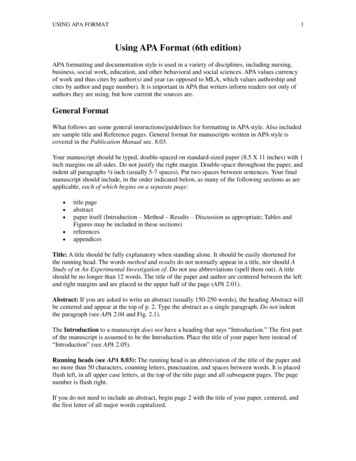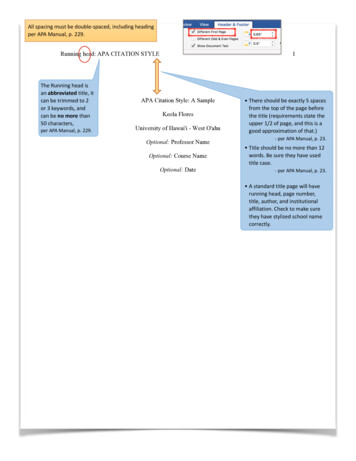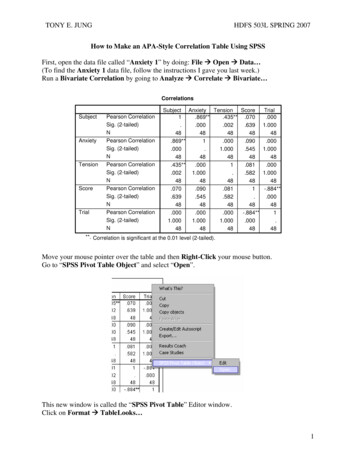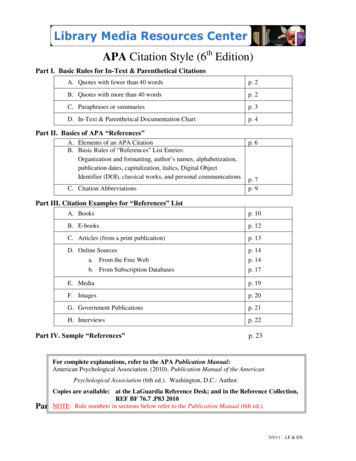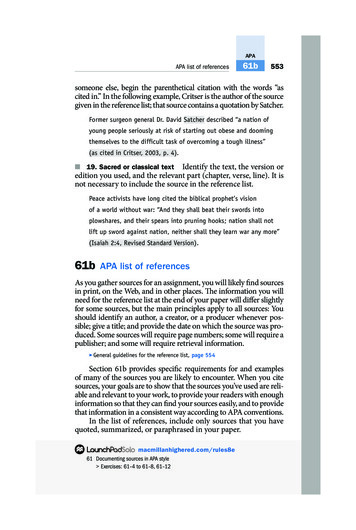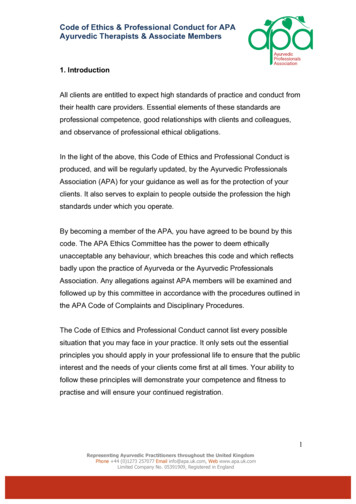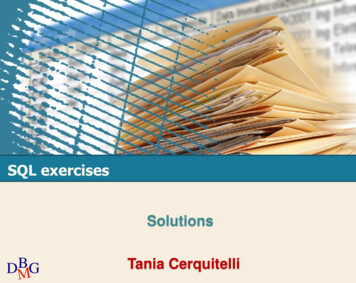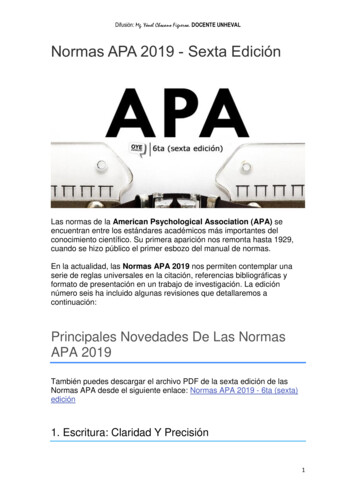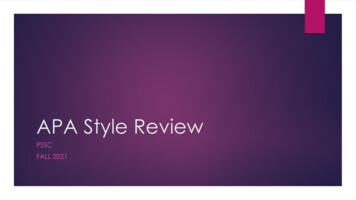
Transcription
APA Style ReviewPSSCFALL 2021
OverviewuuGeneral Review of APA styleuBasic RulesuOnline article citationuIn text citationChanges in the 7th edition
Basic Rules: Most SourcesuAll lines after the first line of each entry in your reference list should be indented one-half inch from the left margin. This is calledhanging indentation.uAll authors' names should be inverted (i.e., last names should be provided first).uAuthors' first and middle names should be written as initials.uFor example, the reference entry for a source written by Jane Marie Smith would begin with "Smith, J. M."uGive the last name and first/middle initials for all authors of a particular work up to and including 20 authors (this is a new rule, as APA 6only required the first six authors). Separate each author’s initials from the next author in the list with a comma. Use an ampersand (&)before the last author’s name. If there are 21 or more authors, use an ellipsis (but no ampersand) after the 19th author, and then addthe final author’s name.uReference list entries should be alphabetized by the last name of the first author of each work.uFor multiple articles by the same author, or authors listed in the same order, list the entries in chronological order, from earliest to mostrecent.uWhen referring to the titles of books, chapters, articles, reports, webpages, or other sources, capitalize only the first letter of the firstword of the title and subtitle, the first word after a colon or a dash in the title, and proper nouns.uNote again that the titles of academic journals are subject to special rules. See section below.uItalicize titles of longer works (e.g., books, edited collections, names of newspapers, and so on).uDo not italicize, underline, or put quotes around the titles of shorter works such as chapters in books or essays in edited collections.
Basic Rules: Articles in AcademicJournalsuPresent journal titles in full.uItalicize journal titles.uMaintain any nonstandard punctuation and capitalization that is used by the journal in its title.uuFor example, you should use PhiloSOPHIA instead of Philosophia, or Past & Present instead of Past and Present.Capitalize all major words in the titles of journals. Note that this differs from the rule for titling other common sources (like books, reports, webpages,and so on) described above.uThis distinction is based on the type of source being cited. Academic journal titles have all major words capitalized, while other sources' titles do not.uCapitalize the first word of the titles and subtitles of journal articles, as well as the first word after a colon or a dash in the title, and any proper nouns.uDo not italicize or underline the article title.uDo not enclose the article title in quotes.uSo, for example, if you need to cite an article titled "Deep Blue: The Mysteries of the Marianas Trench" that was published in the journal Oceanographic Study: APeer-Reviewed Publication, you would write the article title as follows:uuDeep blue: The mysteries of the Marianas Trench.but you would write the journal title as follows:uOceanographic Study: A Peer-Reviewed Publication
Online Article CitationuLastname, F. M., & Lastname, F. M. (Year). Title of article. Title of Periodical, Vol.(Issue), pagenumbers. DOI
In text citationsuuYou can introduce the quotation with a signal phrase that includes theauthor's last name followed by the date of publication in parentheses.uAccording to Jones (1998), "students often had difficulty using APA style,especially when it was their first time" (p. 199).uJones (1998) found "students often had difficulty using APA style" (p. 199); whatimplications does this have for teachers?If you do not include the author’s name in the text of the sentence, placethe author's last name, the year of publication, and the page number inparentheses after the quotation.uShe stated, "Students often had difficulty using APA style" (Jones, 1998, p. 199),but she did not offer an explanation as to why.
Changes from the 6th edition to 7thedition*most relevant to students & teachers from Purdue OWL Online WritingLab
Title pages: Professional vs. studentProfessional title pageStudent title pageuthe title of the paper,uthe title of the paper,uthe name of each author of the paper,uthe name of each author of the paper,uthe affiliation for each author,uthe affiliation for each author (typically the school being attended),uan author note (if desired),uua running head (which also appears on the following pages,the course number and name for which the paper is being written(use the format used by the school or institution (e.g., ENGL 106),a page number (which also appears on the following pages.uuthe course instructor’s name and title (ask for the instructor’s preferredform if possible; e.g., some instructors may prefer “Dr.,” “Ms.,” “Mrs.,”“Mr.,” or a different title),uthe assignment’s due date written in the format most common in yourcountry (e.g., either January 3, 2020, or 3 January 2020 may beappropriate),ua page number (which also appears on the following pages.Note also that student papers now lack a running head.
Heading level6th edition7th edition
Other Format ChangesuRunning heads are no longer required for student papers.uProfessional papers include a running head on every page, including the titlepage. However, the “Running head:” label used in the sixth edition is no longerused.uThe running head is written in all capital letters. The running head should either beidentical to the paper’s title, or a shortened form of the title that conveys the sameidea. However, running heads should not exceed 50 characters (including spacesand punctuation).uThe section labels for abstracts and reference lists follow the conventions forlevel one headings (i.e., in addition to being centered and written in title case,they are also in boldface).uFont guidelines are now somewhat looser in order to account for differences incomputer specifications and users’ accessibility needs. So long as the samefont is used throughout the text of the paper, a variety of fonts are acceptable.
In-text citationsuRegardless of the medium of the source, all sources with three authors ormore are now attributed using the name of the first author followed by “etal.” The only exception to this occurs when doing so would createambiguity (e.g., if two papers have first-listed authors with the samename). In these cases, list as many names as needed to differentiate thepapers, followed by “et al.”uExample: Fannon, Chan, Ramirez, Johnson, and Grimsdottir (2019) and Fannon,Chan, Montego, Daniels, and Miller (2019) can be cited as (Fannon, Chan,Ramirez, et al., 2019) and (Fannon, Chan, Montego, et al., 2019), respectively.
Reference ListuIn the seventh edition, up to 20 authors should now be included in a reference list entry. Forsources with more than 20 authors, after the 19th listed author, any additional authors' names arereplaced with an ellipsis ( ) followed by the final listed author's name. Do not place anampersand before the final author's name.uDigital object identifiers (DOIs) and URLs are now both presented as hyperlinks for electronicsources.uThe label “DOI:” is no longer used for entries that include a DOI.uThe words “Retrieved from” (preceding the URL or DOI) are now only used when a retrieval dateis also provided in the citation.uNew guidelines describe how to use DOIs and URLs when citing sources obtained fromacademic research databases or online archives. In short, you should end thedatabase/archive portion of the citation entry with a period, then provide the DOI or URL.uNote that, though database/archive information is typically not included in citation entries, it should beincluded when writers need to cite sources that are only available within a certain database.
Basic Rules: Most Sources u All lines after the first line of each entry in your reference list should be indented one-half inch from the left margin. This is called hanging indentation. u All authors' names should be inverted (i.e., last names should be provided first). u Authors' first and middle names should be written as initials. u For example, the reference entry for a source written by .
